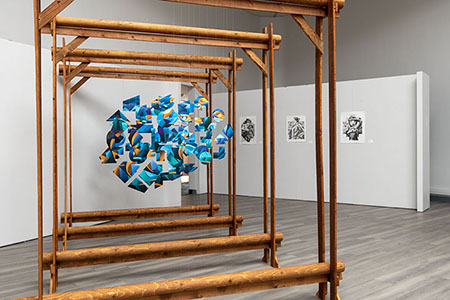
Continuing through April 15, 2023
Arizona-based artist Daniel Nez (Diné) translates oral traditions passed down from Navajo elders into expressive visual narratives. Nez uses geometric forms in his “Fractal Lineage” exhibition to embody elements of Navajo cosmology centered around the Four Worlds. Summaries on the artist’s website describe these worlds, each characterized by the introduction of particular beings, each of these associated with a different color. According to Nez’s descriptions, when one world is destroyed, beings escape into a new one, and each successive world is located closer to the sky.
“First World” (2017, etching, 20 by 15 inches) reveals the cubist sensibilities embodied in all of the eleven works on view. In it, fragments suggest insects emerging from a stark black reality that preceded them. “Second World” (2017, etching, 27 by 21 inches) depicts four birds. Throughout the exhibition, artworks allude to elements of the Navajo creation story — without revealing sacred knowledge not intended for the public. Three 2015 lithographs (all 21 by 15 1/2 inches) center the human species and the Fourth World, as do a pair of 2022 paintings (both 36 by 24 inches) that are based on creation stories of the Bitter Water Clan and the Towering House Clan.
The exhibition is anchored by two large-scale installations that could easily be perceived as mere novelties if considered too hastily or interpreted without context. Nez employs dramatic perspective, which conveys the expanse of both time and space in Navajo cosmology. For each installation, four upright wooden looms are placed one in front of the other. From the top element of each frame-like loom Nez suspends fragments of paintings cut into various shapes, such as a simple circle or stacked triangles that resemble trees. On the backside of several of these, he includes Navajo words or phrases culled from stories passed down many generations. Some include English translations. Dark backgrounds with light lettering allude to the role of language in preserving Navajo culture. In “Blue World” (2019, mixed media, 2019, 87 by 92 by 152 inches), for example, one fragment contains “deego yéego iitah” along with “they flew higher and higher.”
The round bird eyes in Nez’s “Second World” etching reappear in his “Blue World” installation. These works are displayed in close proximity, where they prompt consideration of the fact that stories can be viewed from various perspectives and shared in myriad ways. Similarly, the human forms in Nez’s other works are echoed in the neighboring installation, “White World” (2019, mixed media, 87 by 90 1/2 by 176 inches). In front of each installation, he’s placed a single chair at a precise distance. Those who pause to sit and reflect are rewarded with a unified view in which four layers of fragmented forms appear as a single circular image. Designs on pillows set atop each chair reference the geometry and symmetry inherent in traditional Navajo works, while alluding to the ways geometry is being reimagined by contemporary Indigenous artists. Meanwhile, the looms call to weaving as a form of storytelling.
Collectively, these artworks provide a compelling critique of fragmentation within contemporary life. And they raise a number of significant questions: Has the proliferation of storytelling platforms somehow eclipsed the value of listening and careful observation? Will the actions of human beings bring about the destruction of this, the Fourth World? If there’s a subsequent Fifth World, which beings will populate it? And how will storytelling continue to exist?
Particularly with his installations, which appear to tunnel through space and time, Nez delivers a quiet but powerful homage to storytelling — and its potential to shift perspectives towards greater unity and understanding across cultures and generations.
